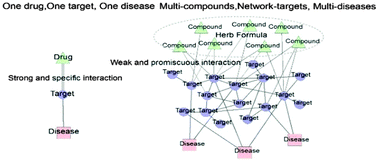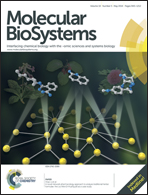A novel network pharmacology approach to analyse traditional herbal formulae: the Liu-Wei-Di-Huang pill as a case study†
Abstract
Understanding the mechanisms of the pharmacological effects of herbal formulae from traditional Chinese medicine (TCM) is important for their appropriate application. However, this understanding has been impeded by the complex nature of herbal formulae. A herbal formula is a mixture of hundreds of chemical ingredients with multiple potential targets. The effects produced by an entire herbal formula cannot be adequately explained by considering separately each ingredient in it. This is a recognised problem that remains in need of methods to solve it. Here we introduce a holistic analysis method to decipher the molecular mechanisms of herbal formulae. This method combines chemical and therapeutic properties with network pharmacology, using a novel approach to evaluate the importance of the targets and ingredients of herbal formulae. We used the Liu-Wei-Di-Huang (LWDH) pill, a classic herbal formula, as an example to illustrate our method and validated some results by a following experiment. We revealed the core molecular targets and bioprocess network of the pharmacological effects of LWDH and inferred its therapeutic indications. This method provides a novel strategy to understand the mechanisms of herbal formulae in a holistic way and implies new applications of classic herbal formulae.


 Please wait while we load your content...
Please wait while we load your content...